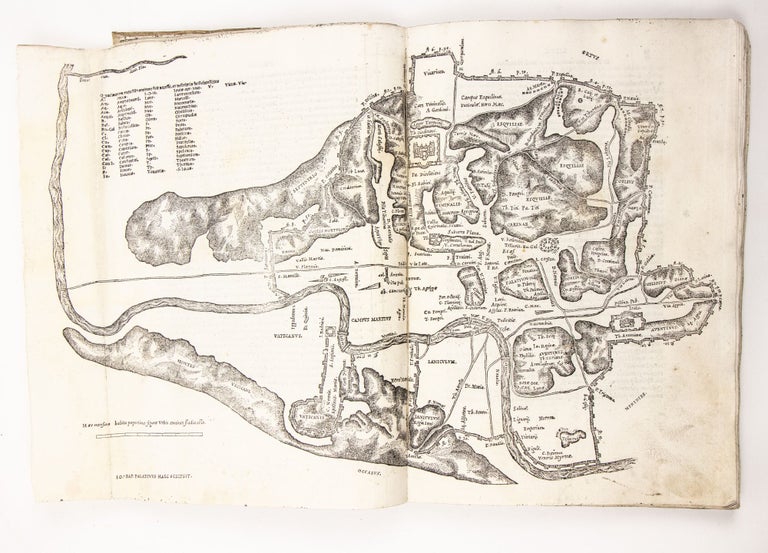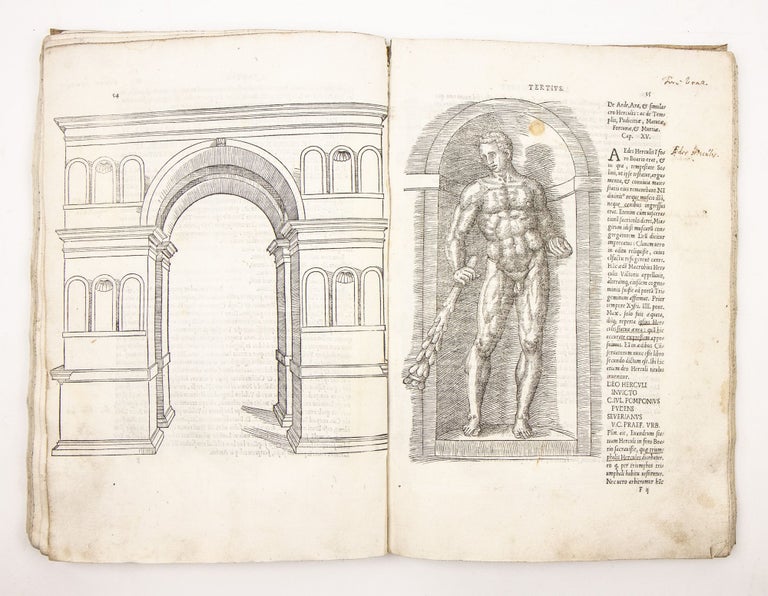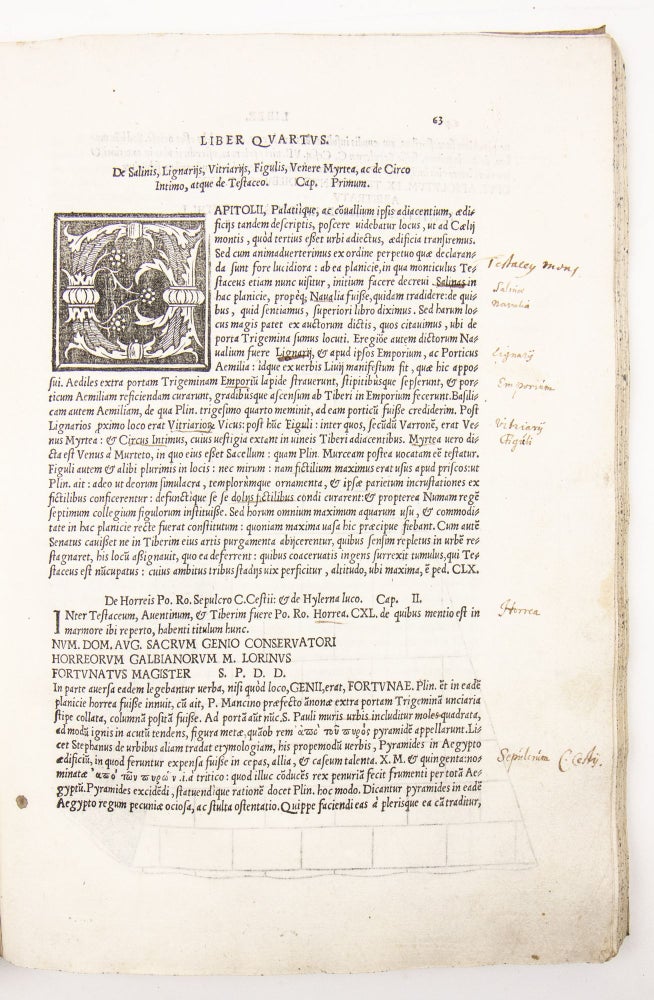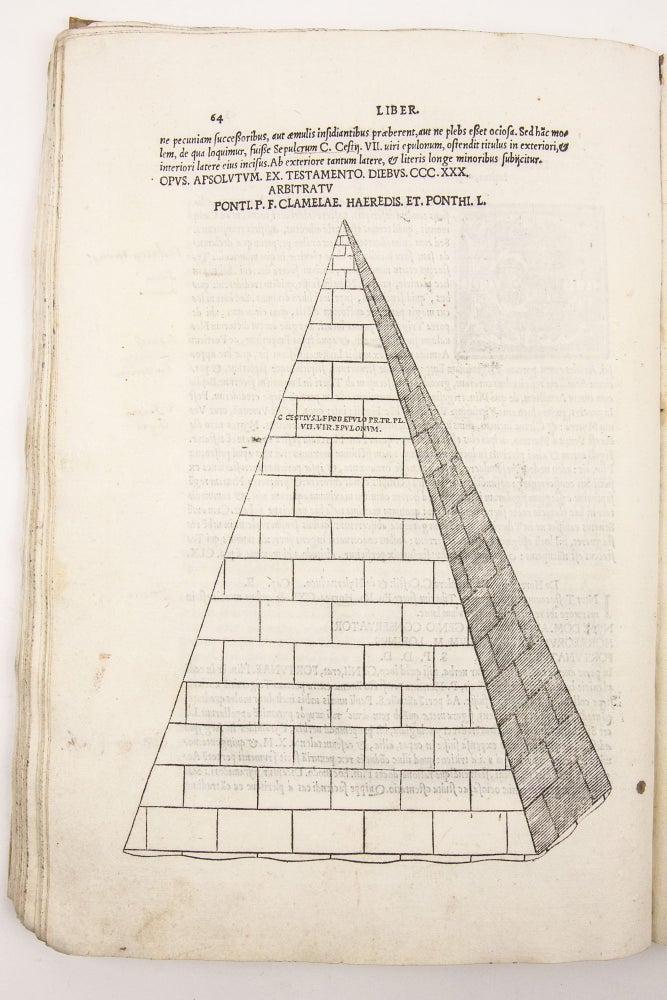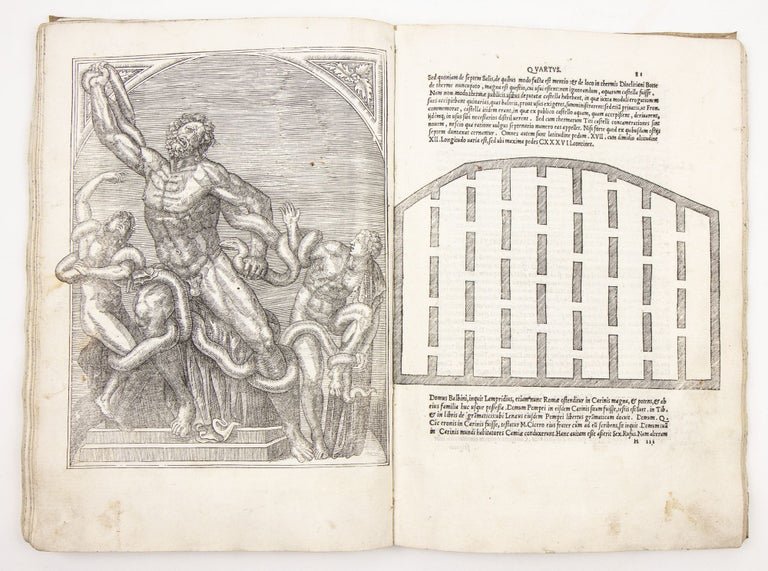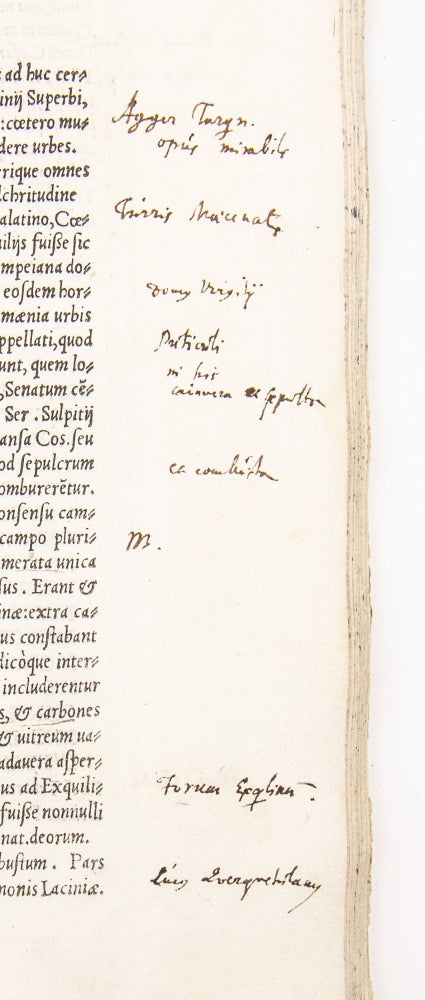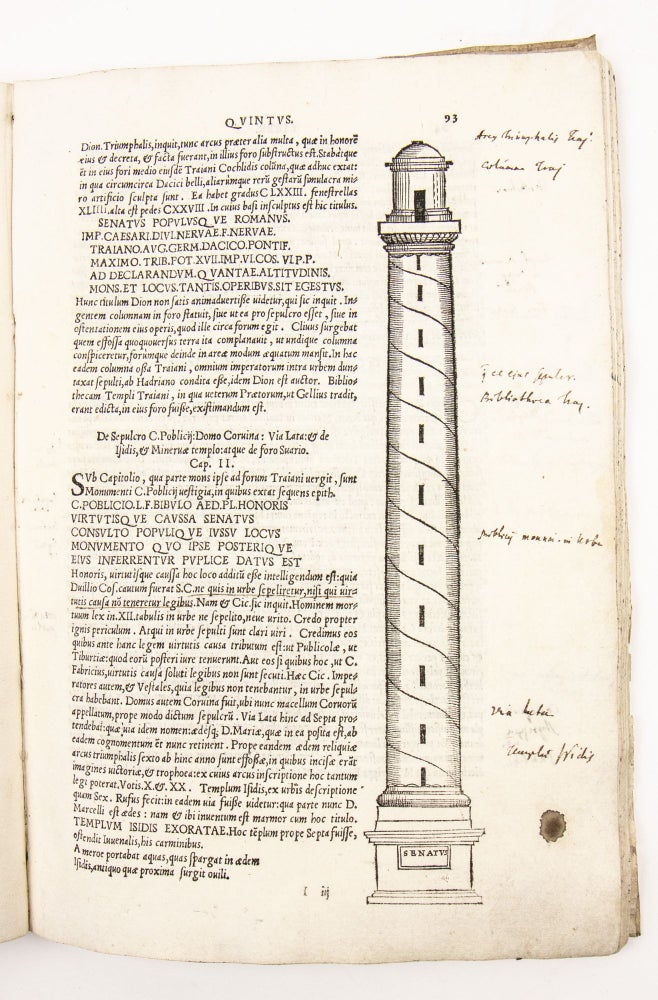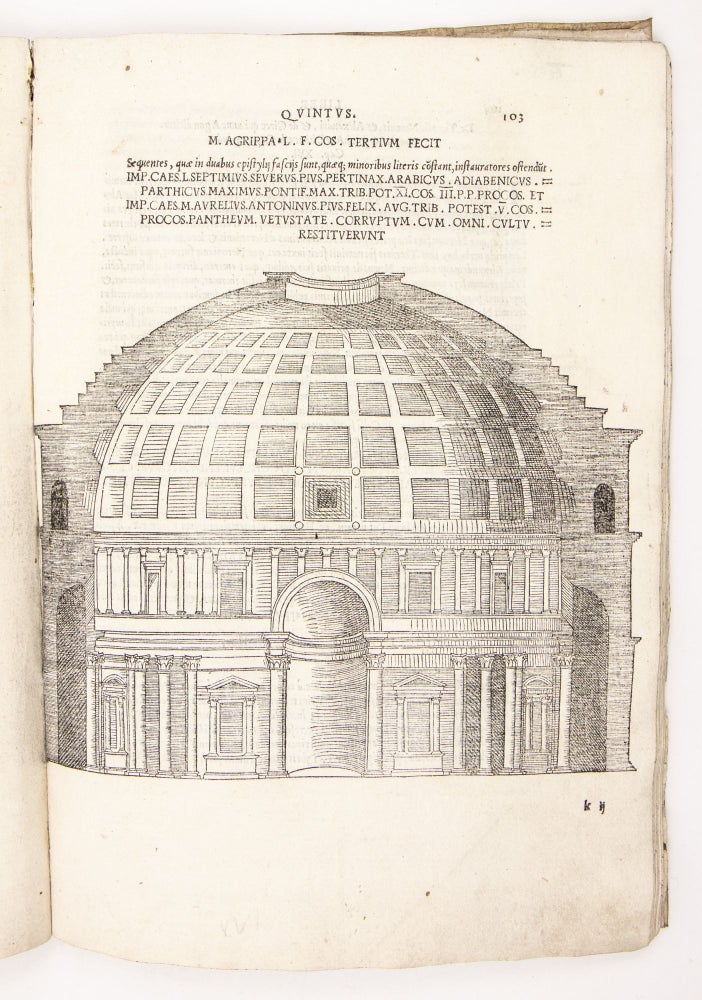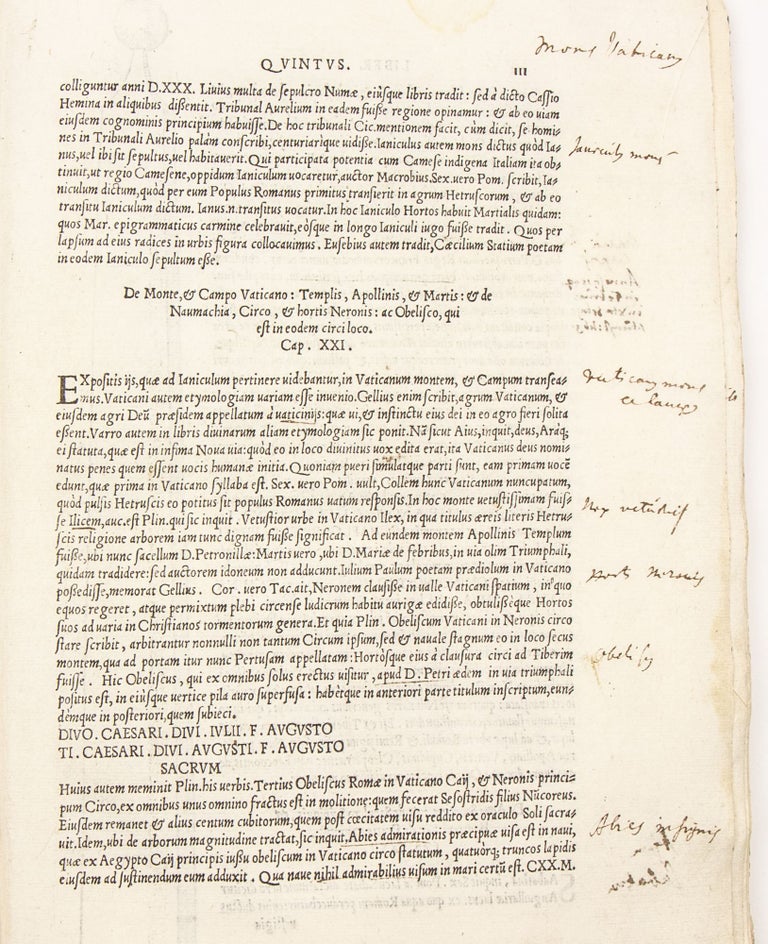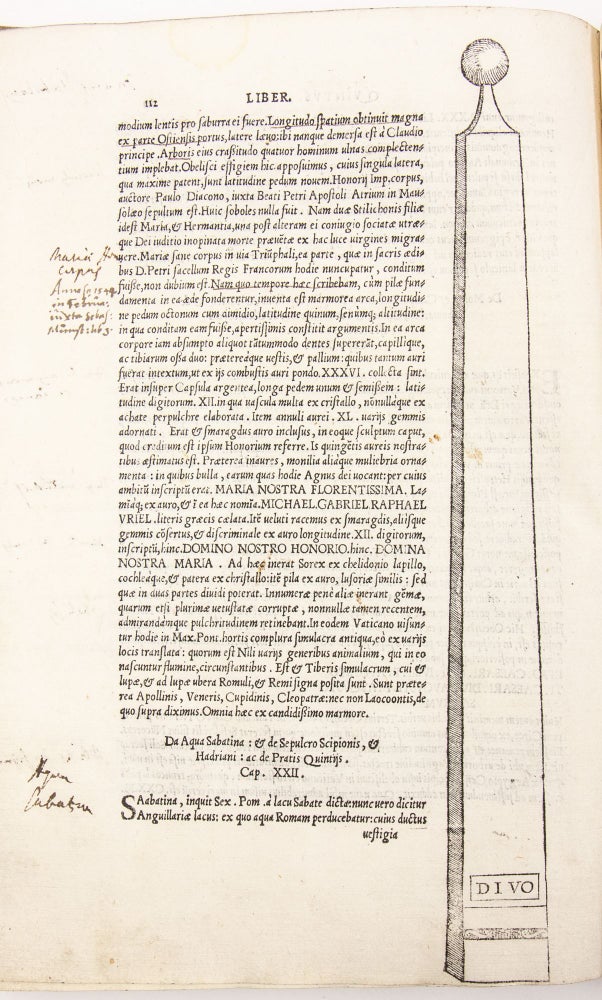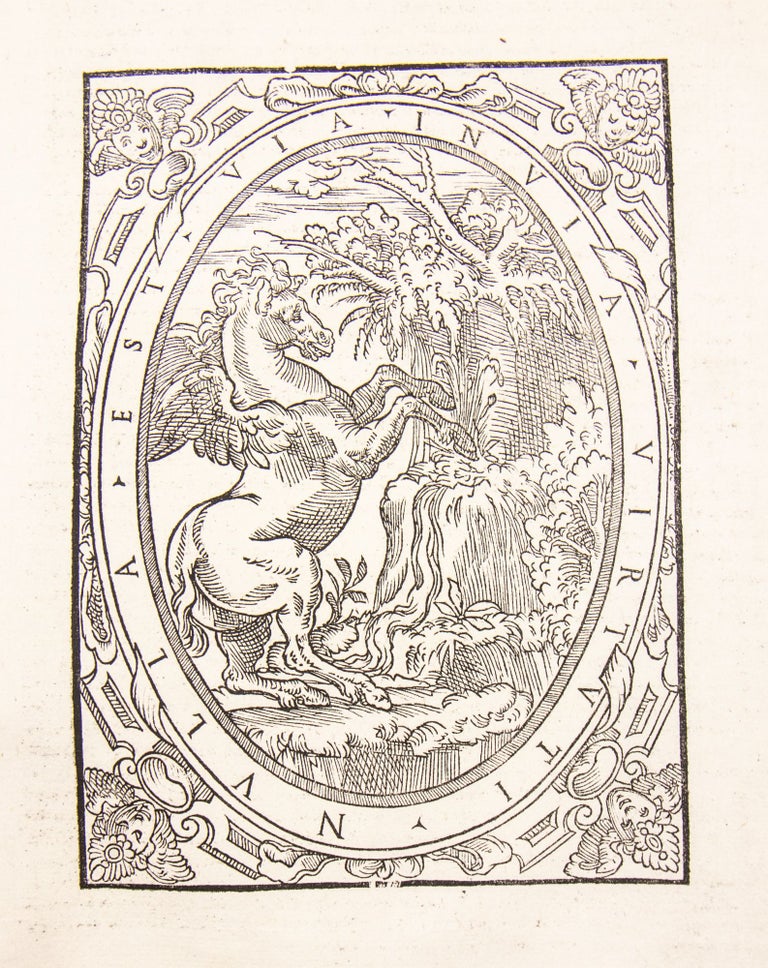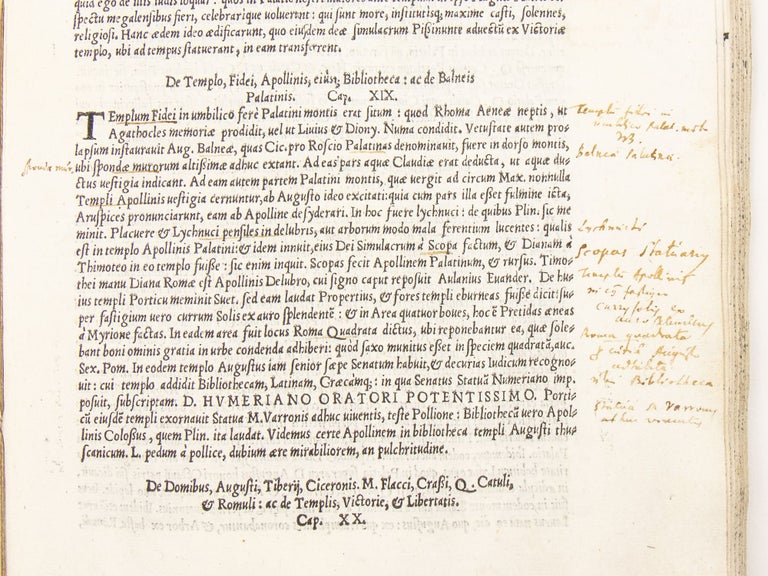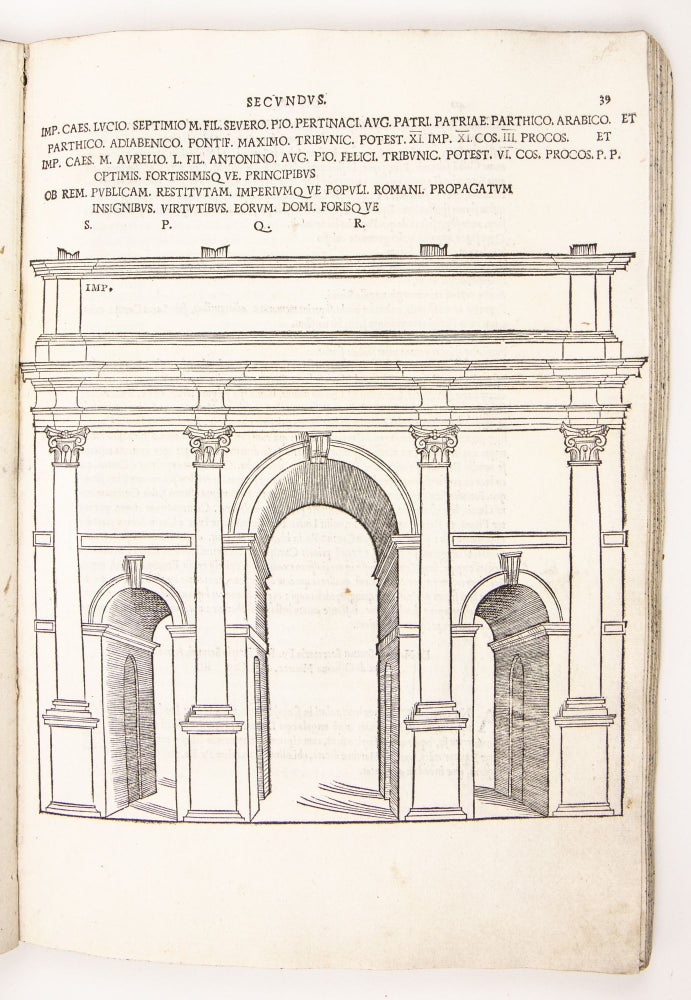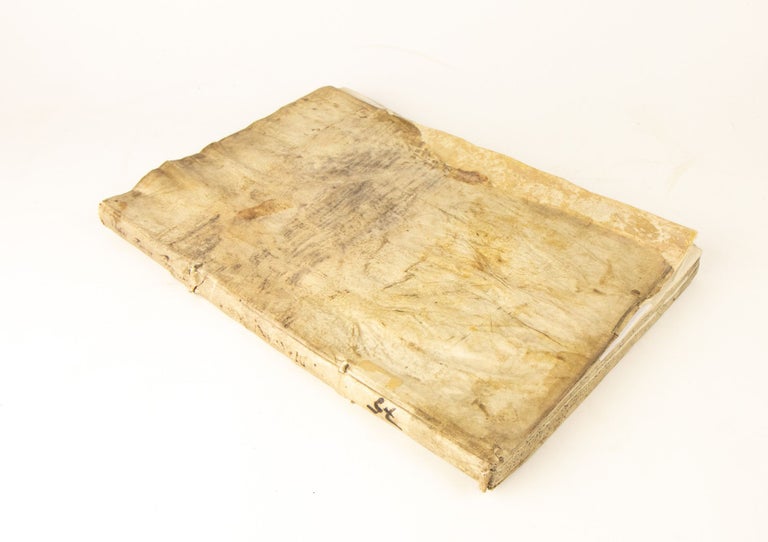Vrbis Romae topographia B. Marliani ad Franciscvm Regem Gallorvm eivsdem vrbis liberatorem invictvm. Adiecta priori eiusdem auctoris topographiae editioni in hoc opere sunt. Vrbis, atque insignium in ea aedificiorum descriptiones, compluràque alia memoratu digna. Errores nonnulli sublati. Tituli, inscriptionèsque non aliter, quàm ipsis inerant marmoribus, emendatissime expressi, qui ab aliis hactenus neglecto ordine, & perperam in lucem editi inveniuntur. Cum Priuilegio Pauli . III . Pont. Max. cuius exemplum in fine libri impressum est
Rome: Valerio and Luigi Dorico, 1544.
Price: $15,000.00
Folio: 30.5 x 21 cm. [12], 122, [2] pp. A6, A-B4, C-L6
FIRST ILLUSTRATED EDITION, the first folio edition, and the third edition overall. Complete with the folding engraved map of Rome by Palatino (Frutaz 12). The often-lacking colophon leaf with the full-paged Pegasus printer’s device (Ascarelli fig. 24) is also present. This is the first issue, the only issue to print the text of the privilege from Pope Paul III.
This is an exceptionally large copy, with none of the usual trimming to the oversized woodcuts that illustrate the volume. It is one of the two largest copies that I have handled. Bound in contemporary limp vellum, laced through with the original rawhide sewing supports intact. The binding is entirely unsophisticated and shows signs of wear, particularly to the front board, which has suffered some loss to the vellum, exposing the paper lining the binding. The title page is soiled and has a faded ink spatter plus two old German institutional stamps in the blank margin. There is a discreet paper repair to the map fold. The leaves have generous margins in which a 16th century reader has made numerous glosses.
Illustrated with 23 fine woodcut illustrations (of which five are full-paged), including a double-page map of Rome signed by the calligrapher Giovanni Battista Palatino (Frutaz 12). The map is of great importance in the history of Roman cartography, as it is the source for Bufalini’s plan of 1551, which in turn served the model for Nolli’s plan of 1748.
The most famous and influential of the illustrations is a full-paged woodcut of the spectacular sculptural grouping of Laocoön and his sons, a Roman marble copy of a Hellenistic original, discovered in the Baths of Titus in January, 1506 and removed to the Vatican at the direction of Julius II. Other important works depicted include the Capitoline Wolf, a fifth-century masterpiece of Etruscan bronze casting; a fine cross-section of the Pantheon; Constantine’s Church of Santa Costanza.
THE PALATINO MAP: The folding topographical map of Rome, signed by the calligrapher Giovanni Battista Palatino, is the first true topographical map of the city, showing the locations of the extant archaeological ruins, to appear in a printed book. It marks a great advance over the earlier, stylized “maps” that appeared in Marco Fabio Calvo’s “Simulacrum” (Rome: 1527), in which crude, largely symbolic representations of the monuments and geographical features floated, with little relationship to each other on a flat plain. By contrast, the Palatino map shows careful observation and delineation both of the monuments and the topographical features of the city. A significant advance, one that anticipates Bufalini’s plan of 1551, is the depiction of some of the major monuments in architectural plan. This allows us to see the precise orientation of the buildings with respect to the topography. The scale is expressed in stades; the Aurelian Walls are measured in both stades and passi.
“Marliani’s map is the first scientifically designed topographical (ichnographic and orographic) map of Rome. Certainly Bufalini worked on it, or at least the creator of this map was able to profit from Bufalini’s surveys, as a comparison of the two plans shows.”(Frutaz, 12)
“The source of the first Bufalini plan is the topographical map of Rome published by Bartolomeo Marliani inserted in the third edition (1544) of his ‘Urbis Romae Topographia’ (Rome: 1544), which has the same orientation and accuracy as Bufalini’s.”(Dizionario Biografico degli Italiani).
“The modest dimensions of [Marliani’s map] belie its historical importance as the first printed orthogonal plan of the city with all its elements shown to scale. Oriented with north at left (thereafter the predominant orientation for maps of Rome until the eighteenth-century), it is a streamlined presentation… Only those elements of Imperial Rome that were still visible in his own time, such as the Baths of Caracalla and the Colosseum, are represented visually, while those that had disappeared but whose locations he was able to glean from ancient authors are signalled in text. In this way, Marliani’s choices reflect the physical reality of the sixteenth-century city, so that his representation is not a reconstruction of ancient Rome per se, but rather a map of its contemporary twin from which he peeled away all later accretions to leave only the survivals from antiquity.”(Maier, Roma Renascens)
The illustrations are as follows: the ancient city as established by Romulus, comprising the Palatine and the Capitoline hills (leaf A2); the ancient city comprising the Seven hills of Rome, Tiber Island, and the Janiculum (leaf A4); a two-page, folding map of the city and its environs at the time of Constantine, showing the major monuments (leaves B2-B3); the Capitoline Wolf (leaf C5); the Arch of Septimius Severus in the Roman Forum (leaf D6); a Corinthian column from the Temple of the Empress Faustina, wife of Antoninus Pius (leaf E1); the Basilica of Constantine (leaf E3); the Arch of Janus Quadrifons (leaf F1); the colossal bronze statue of Hercules from the Temple of Hercules in the Forum Boarium (Leaf F2); the Temple of Portunus (leaf F3r); the Temple of Hercules Victor (leaf F3v); the Circus Maximus (leaf F4); the pyramidal tomb of Gaius Cestius (leaf F6); the Septizonium of Septimius Severus (leaf G2); the Curia Hostilia on the Caelian Hill (G4); the Laocoön (leaf H2); the Baths of Titus on the Esquiline (leaf H3); a section of the Baths of Diocletian (leaf H6); the Column of Trajan (leaf I3); the Pantheon (leaf K2); the Pons Fabricius, one of the ancient bridges linking Tiber Island to the mainland (leaf K4); the Vatican obelisk (leaf K6); and the early Christian church of Santa Costanza (leaf L2).
First illustrated edition of Marliani’s important guide to Rome, featuring striking woodcuts of the city’s chief antiquities, and including one of the earliest descriptions of the Laocoön. “Urbis Romae topographia” was one of the most popular of the new type of scholarly guidebooks that were written to satisfy the burgeoning interest in archaeology and antiquarian research by describing the main ancient works of art and classical sites. "Scholars and artists who could not manage a trip to Rome could still learn much from images and explanations like Marliani’s" (Grafton, ‘Rome Reborn”, p. 110).
“Urbis Romae topographia” was first printed in octavo by Antonio Blado at Rome in 1534; a second edition appeared the same year in Lyon and included a dedication by Rabelais. The text in this, the third edition, first issue, has been considerably revised for the folio format. It contains a new dedication to François I of France. According to Mortimer 284, this first issue contains the original address to the reader as well as the work’s privilege, which was omitted entirely from the second issue when leaves L2 and L5 were reset to accommodate additions to the errata.
Fowler 189; Mortimer Italian, 284; Adams M-610 (this issue); Berlin Katalog 1831; Brunet III.1437; Cicognara 3778; Schudt, Le Guide di Roma, 605; Rossetti G-308; Borroni II.7923.3; Schlosser p. 601; Fossati Bellani 903; Olschki 17512; on the map: Fruatz, Le Piante di Roma, Vol. I, No. 12


